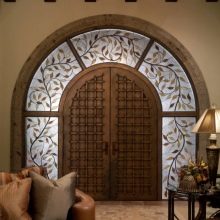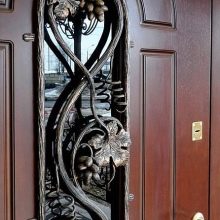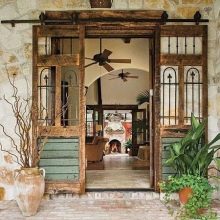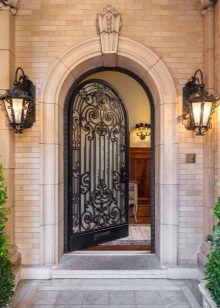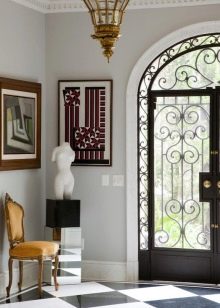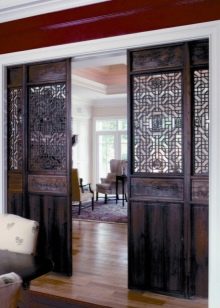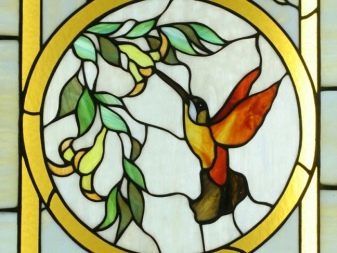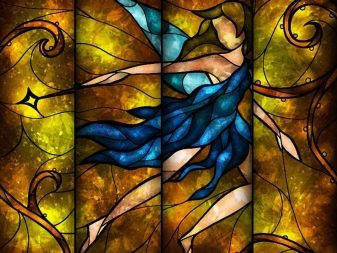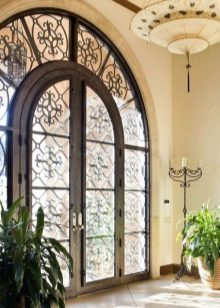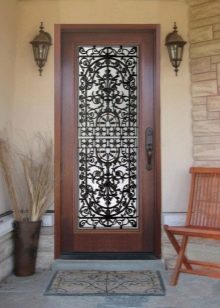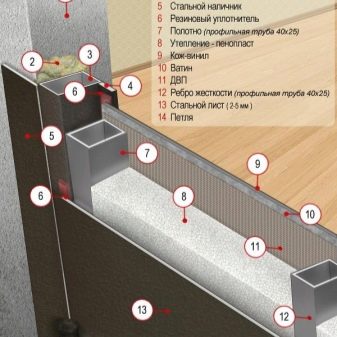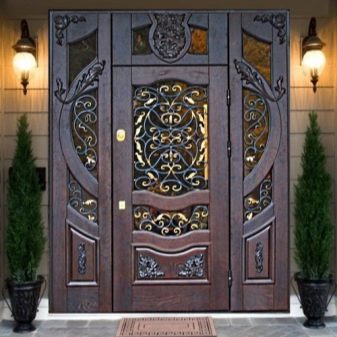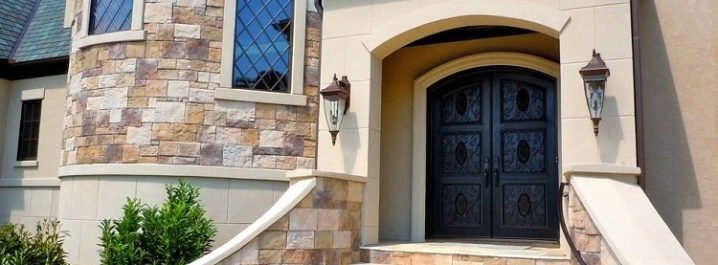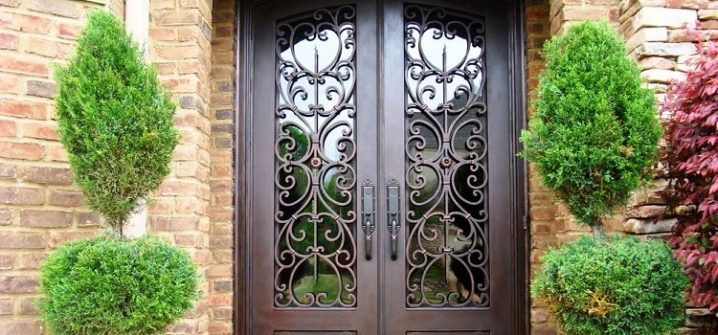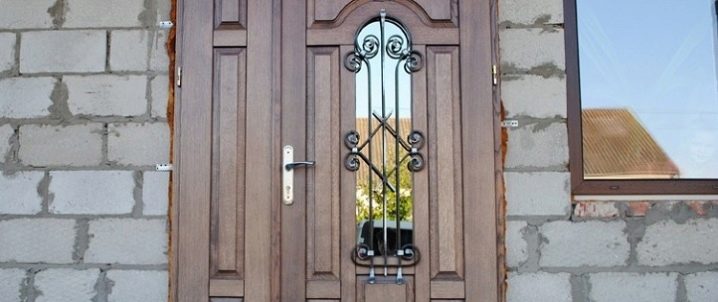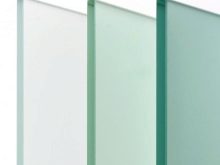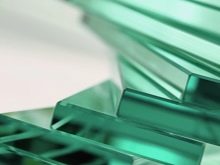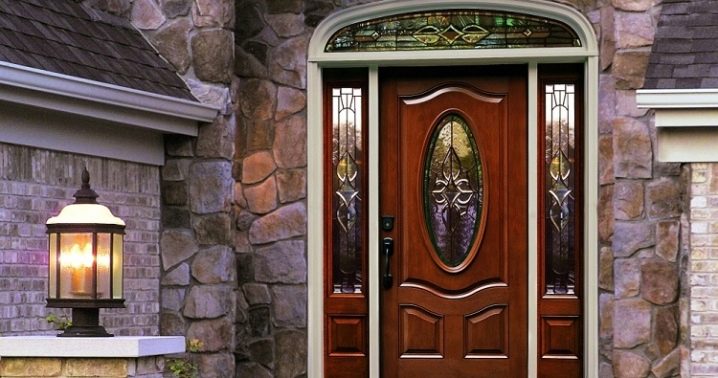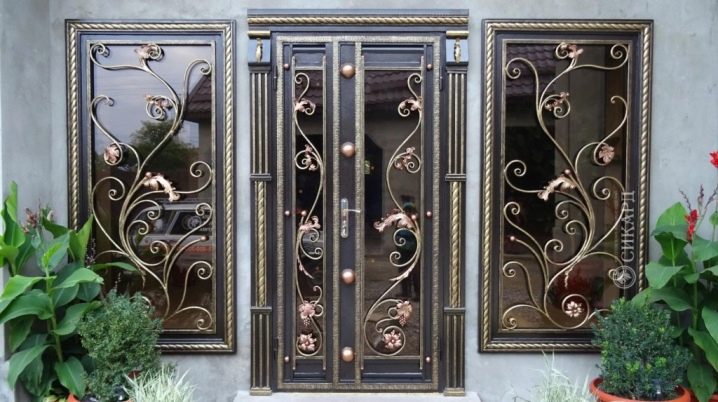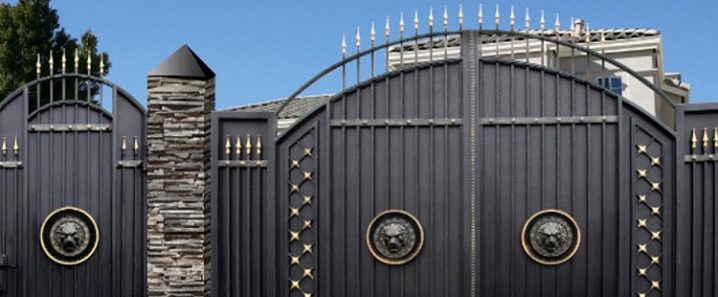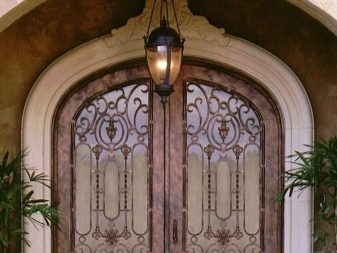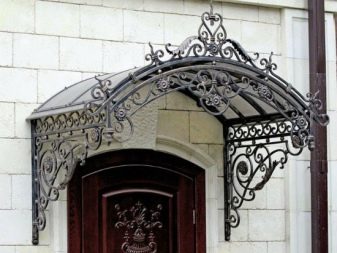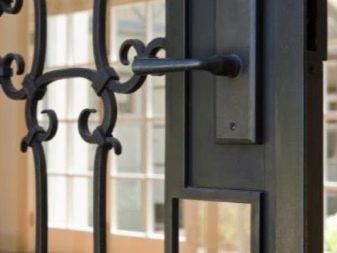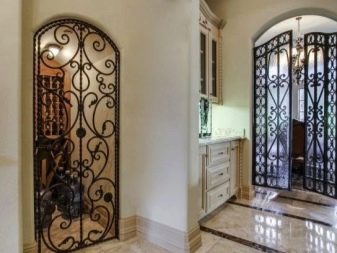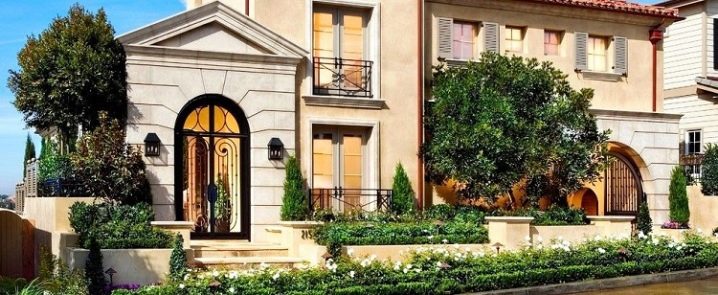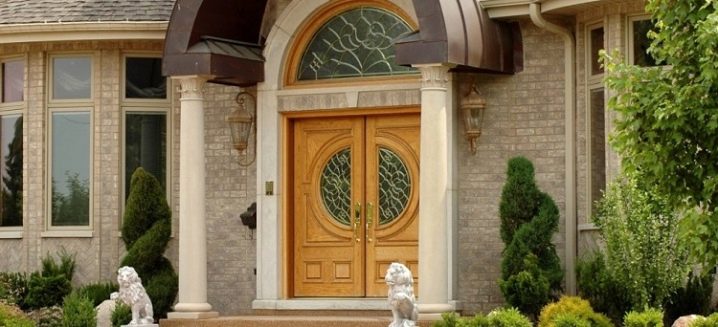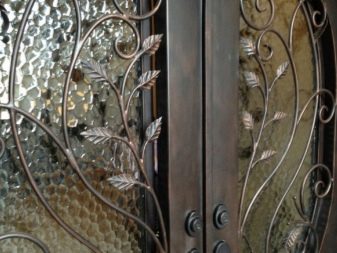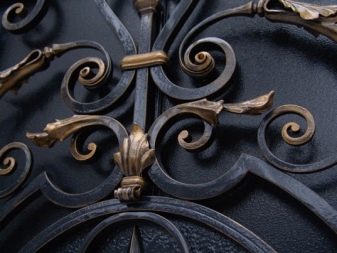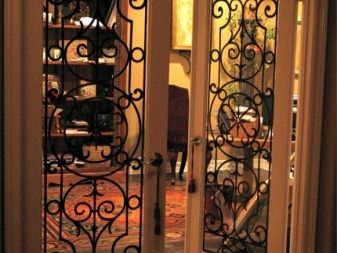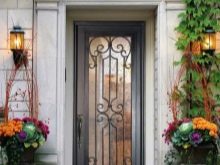Features forged doors
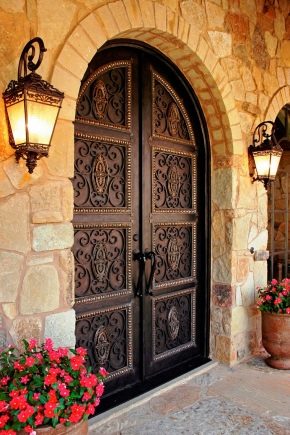
The craft of art forging originated in ancient Egypt. For many centuries, forged products do not lose their popularity. Forged elements decorate not only windows and furniture, but also entrance and interior doors. This article will consider the features of wrought doors.
Kinds
Forged doors can be divided into different categories:
- By installation distinguish between input and interior models. Since forged elements most often decorate outdoor products rather than the interior of the room, forged entrance doors are much more common than interior doors. By design, there are two-leaf and single-leaf doors.
- By way of opening door leaf distinguish swing and sliding products. The most common option is swing systems. Such products are easy to install and less bulky compared to sliding models. The hinged door design is complemented by large hinges. Sliding systems are more massive and bulky.
By design can distinguish the following types:
- with solid door leaf;
- with composite door leaf.
Door leaves are made as deaf (from one material), and with additional elements. Doors are often decorated with elements of forging complete with glass or other materials.
Glass visually makes forged doors less heavy. Also popular are the combined models with the top insert and the forged element.
Materials
The main material for the manufacture of forged door structures is metal. Iron products manufacturers often complement tempered or armored glass, which ensures the strength of the entrance door. The following types of glass manufacturing techniques used for decorating forged models can be distinguished:
- Stalin This glass is different from the usual production technology. In the manufacture of glass is first exposed to high temperatures, and then uniform cooling of the surface on both sides. This production method provides glass with high strength and resistance to thermal and mechanical stress.
- Tiffany The Tiffany technique is different from other ways of connecting glasses. After grinding, the glass is framed with copper tape and interconnected with tin solder. Ready stained glass covered with patina.
- Stained glass window considered a separate type of decorative art. It is combined from glasses of different colors and serves as an exclusively decorative element.
- Fusing With this technology, the glass is first heated, and then aged for some time under the influence of a certain temperature. When the product takes the desired shape, it is subjected to rapid cooling.
A less popular option is plastic inserts. The advantage of the model with plastic elements is the relatively small weight of the door. Also, forged doors differ not only in exterior but also in interior.
The inner side of the product is often sheathed with wood. Popular wooden models with forged metal plates.
Dimensions
For the size of the door in the first place is responsible for its design. Double-leaf products are heavier. Improper installation of such a product may damage the wall. When installing the door as a frame, you must install strong metal plates. This model is suitable for wide doorways.
Despite the fact that the metal seems rather coarse and massive, there are also models of small sizes with neat light shapes. Most often these are single-leaf doors with forged plates or glass inserts.
Elements of construction
Forged doors are produced both without additional inserts in the construction (deaf) and with fragments of glass. Door leafs with additional glass inserts have no less durability compared with models made entirely of metal.
The following elements are most often present in a complete set of a shod door:
- Metal door leaf (more than two millimeters thick).
- High-strength box made of metal profile.
- Stiffeners, which further reinforce the design.
- Durable hinges (mainly flag type). Such loops are able to withstand heavy loads.
- Safe locks, which have additional locking elements. Hacking such a lock will be extremely difficult.
For the manufacture of forged and lattice sets use the following materials:
- corners;
- shaped tubes;
- rods of various diameters;
- corrugated reinforcement.
Tips
For the manufacture of entrance and interior doors use a variety of materials: plastic, glass, wood, metal. Each material has its advantages and disadvantages, which need to be paid attention to when choosing the appropriate model. Let's compare products made from different materials, which can help in the future when choosing the appropriate version of the door structure.
What is better plastic or iron?
- Plastic is relatively cheap, but at the same time practical and harmless material. Plastic doors have many options for finishing and a lot of colors, which allows you to choose a product for any interior.
In addition, the plastic model is moisture resistant and has high sound and heat insulation performance.
Compared to wrought iron models, plastic doors cannot boast of such high strength and reliability. It is preferable to use metal doors as input structures rather than PVC.
- Glass doors have no less original appearance than metal models with forging elements. Although glass is inferior to iron in strength, it is extremely difficult to break such a door due to the following features of the material used:
- Triplex. It is a laminated glass. Polymer film, with the help of which glass is glued together, is capable of holding fragments upon impact.
- Matolyuks. In other words - tempered frosted glass. Transmits the light, but does not allow to see what is happening behind the door. It has a hardness of five times higher than ordinary glass.
- Strained glass. Thanks to a special manufacturing technology, it is highly resistant to mechanical stress (ten times stronger than ordinary glass). Despite all the advantages of glass products, such doors are most often produced as interior doors.options.
This model is suitable for small apartments that can not be said about the metal door designs.
- Wooden doors differ in environmental friendliness and durability. A significant drawback of such products can be called poor moisture tolerance, which can lead to deformation of the door leaf.
Wood models are considered a classic and versatile option for all types of premises. It is easy to choose the right door for installation at the entrance of the room, and as an interior option.
- Forged metal doors in no way inferior to models made from other materials. Due to the massiveness of the construction, iron products are mainly installed at the entrance to the premises. Of course, there are exceptions: in large country houses metal wrought-iron doors will look great not only in the exterior, but also in the interior of the room.
How to choose?
When choosing forged structures you should pay attention to the quality of the material. Products made from high-quality metals are more reliable and less susceptible to corrosion. In addition to the material of the door structure, the purpose of the room in which the forged model will be installed, as well as the interior and exterior design is of great importance.
For a private house an excellent option would be wrought iron gates from the corners. Corners produced using the method of hot rolled. Due to the shape of the material and high rigidity, such doors can withstand heavy loads. Wrought iron gates from the corners have high strength and durability.
Antique doors are distinguished by their size and large mass. This model is decorated with coarse metal elements. Antique doors are visually similar to the entrance structures of ancient castles.
Exquisitely and sophisticated look model with glass inserts or with a window. Often, in addition to such products, wrought canopies are installed on the door (to protect it from precipitation). As you know, forged doors are quite expensive.
Alternatively, you can install a model with forged linings. The basis of this product is the usual door leaf, which are attached forged decorative elements.
Advantages and disadvantages
Forged entrance doors will serve not only as reliable structures, but also emphasize the prestige of the house.
The main advantages of such products include:
- Easy to care.Metal forged doors do not require constant and special care. Such products retain their original appearance for many years.
- High strength and durability.
- Resistance to mechanical stress and damage. Street variants are often subjected to additional treatment with anti-corrosion agents.
- Soundproofing.
- Thermal insulation.
- Reliability. A wrought-iron door is harder to crack than a regular steel model.
- Original exclusive design. Often decorative forged elements of door designs are made by craftsmen in a single copy. Patterns can be folded into geometric patterns and abstract compositions.
The main disadvantage of forged models can be attributed to the high cost. But the exclusivity and high reliability and durability of the product compensate for the high price. Forged doors are not suitable for installation in all rooms. This model will clutter an apartment with a small area. Another disadvantage is the likelihood of metal corrosion, which may be subject to models of low-quality material.
Design
For the variety of options for the manufacture of forged doors are responsible for the various designs and materials used, as well as forged items. Such elements perform not only decorative, but also an additional protective function.
Forged grilles on the door are made in the form of a frame, the inner space of which is filled with metal elements of various shapes. Forged grilles look good in combination with glass inserts on the door.
Forged handles have a wide range of models, but can also be made to order according to individual sketches.
Such elements look stylish and elegant, so forged handles can be considered as an additional decoration of the door structure.
Such elements often have a bronze or gold finish. Look harmoniously on both wooden and metal structures. In addition to the exclusive and original appearance, such accessories are durable and durable.
Forged door linings are metal products that are used to connect and fasten other elements or as a separate decoration of arrays.Forged patterns on the gate are mainly made in the form of plant elements, various geometric patterns and monograms.
Successful examples and beautiful options
The original exclusive author's model with elements of forging, creating a floral arrangement. The model looks unusually light and fits perfectly into the exterior of the building. Such a design would be an excellent option for a private house.
A wooden double door with glass inserts and forged linings will accentuate the refined interior of the room. The soft light passing through the glass in the room will create an atmosphere of warmth and comfort.
A massive forged door, supplemented by an arch, will emphasize the good taste and high status of the owner of the room. This model is suitable for installation in the cottage.
Forged patterns can complement models of wood. Metal inserts in combination with glass do not make the product heavier and are in perfect harmony with the light tones of the door leaf.
In spite of the fact that models with forging elements evoke associations with something bulky and heavy, there are small entrance doors for narrow doorways.
In this video you will find even more ideas for a successful door design.
